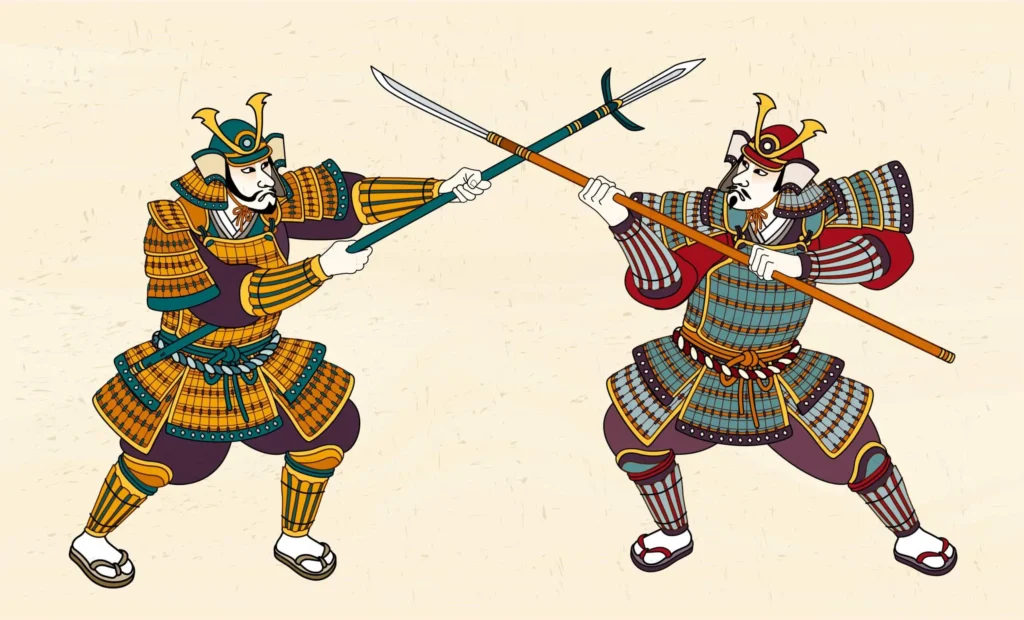
Famous historical characters in Japan are the samurai. Clad in some of the most exquisite yet very effective armor pieces in global history, the samurai defended Japan’s borders against foreign invaders for seven centuries, all the while upholding the shogun-led feudal regime. These are ten fascinating facts about the mythical warriors of Japan.
1. For over a millennium, there were samurai warriors.
With good reason, the samurai are a legendary figure in Japanese history. From the late 1100s to the late 1800s, this caste gained notoriety. Even though this historical period was similar to many protracted feudal systems seen around the world, it is nonetheless rather remarkable. In the 12th century, local fighting organizations gave rise to the samurai caste structure. Europe was still mired in the Dark Ages at the time, and Marco Polo had not yet sailed to China.
The first vehicle, telephone, and incandescent lightbulb were created before the end of the samurai era in the 19th century, and the first airplane took to the sky less than 20 years later. It’s amazing how effectively this age held onto power despite the enormous technical advancements made in the globe, and how quickly it came to an end.
2. I found peacetime to be rather dull.
Don’t believe that the 700-year history of the samurai was just focused on swordplay. Even though the samurai saw plenty of combat throughout the years, especially while facing Mongolian invasions, they frequently kept their katanas holstered. Remember that even in times of peace, the samurai’s duty was to serve their master.
Many worked as farmers or in other peaceful occupations. The period from 1600 to 1868 saw them study Confucian classics, become administrators, and learn a trade, while they were still expected to maintain their talents. Known by its Japanese name, the Edo era was a protracted period of calm that ended with the collapse of the feudal system and samurai.
3. Samurai engaged in combat outside of Japan
The best skills of the samurai did not go to waste in times of peace just because a feudal lord was not at war. To further the objectives of their lords, many traveled alone or in groups outside of Japan. Some of the samurai are thought to have also resorted to piracy.
The Wokou were a mixed-Asian pirate organization that operated during the 1300s and 1500s. Because historians have discovered Japanese armor and weapons on these ships, they are inclined to think that some samurai sailed on their own initiative or at the behest of their superiors.
4. Feudalism killed Japan’s honorable samurai…as the evil people
To paraphrase a well-known movie plot, you either die a noble person inside a caste system or you survive long enough to witness its dissolution and join the rebels. Recall that Japan had enjoyed over 250 years of peace during the Edo era by 1867. Even though they were still skilled fighters, many samurai adopted other peaceful professions in society.
Japan’s modernization resulted in a return to imperialism and the dissolution of the feudal order. Known as the Meiji Restoration, a large number of samurai quit their positions and later rose up in rebellion against the newly installed government. The final samurai to die in Japan put an end to the Satsuma Rebellion.
5. In California, there was an unsuccessful samurai colony.
Samurai were among the thousands who departed Japan in the 1800s when the country’s topography altered. An ex-military advisor to a Japanese king brought his three families to San Francisco in 1869 with the intention of founding a colony for other foreigners who were still tied to the collapsing feudal system.
The immigrants, headed by a Prussian called John Henry Schnell, traveled to California to establish Wakamatsu Silk and Tea Farm, with the intention of inspiring hundreds more samurai and Japanese people to escape the civil war that was still raging. Regretfully, not one did. The last samurai colony founded outside of Japan came to an end when the colonists scattered due to a lack of funding and water for the farm.
If you’ve been itching for an extended journey through Japanese history, Trafalgar’s Classic Japan tour offers 11 days filled with unforgettable events. You’ll board a bullet train from Tokyo to Osaka, visit Kyoto to meet the geishas, and snap pictures with Mount Fuji.
6. You won’t see many people carrying katanas in Japan these days.
The good news is that you may get your own custom-crafted samurai sword made the old-fashioned way when you visit Japan.
The unfortunate news is that you cannot transport it through Japan’s streets.
In Japan, carrying a katana is forbidden. In reality, the Japanese Firearms and Sword Law states that you may only lawfully own a katana in Japan if it is registered. This applies to both modern and vintage katanas.
7. They employed firearms among their other weapons.
Assume again if you assume a samurai would simply use a katana.
For hundreds of years, the primary weapons used by both samurai and troops in Japan were bows and spears. In addition to their katanas, they carried two more blades: small swords known as wakizashi and knives known as tantos. Although wakizashi and tantos were frequently used, katanas were the samurai’s primary weaponry.
And weapons? They had their katanas holstered next to them.
When guns were introduced to Japan in the 16th century, the samurai’s style of fighting was altered. The nation really possessed more firearms than any other country in Europe, and the samurai were not afraid to employ this advantage.
But in the 1600s, the shoguns banned firearms in Japan, scared of a peasant insurrection with weapons.
8. Many of the contemporary martial arts may be traced back to the samurai.
Just as we don’t typically see samurai brandishing firearms in combat like to a cowboy, we also don’t typically picture Japanese warriors employing chokeholds and takedowns similar to those of an MMA fighter.
Indeed, they did.
In order to give samurai an offensive option in close quarters battle in the event that their swords and knives were unavailable, jujutsu was invented in feudal Japan.
Traditional Japanese jujutsu organically developed into several styles as it was altered by its numerous unique instructors; many of these forms now identify as distinct martial arts courses. Brazilian jiu-jitsu, judo, sambo, and aikido are all derived from the hand-to-hand fighting techniques of the samurai.
9. Seppuku was as frequent, violent, and recent as the media makes it out to be.
Many movies and TV series feature a Japanese character—typically a samurai or ninja—bravely carrying out a noble “hara-kiri” death. This ritualistic kind of suicide, also known as “seppuku,” creates a dramatic moment for the media.
Furthermore, although seppuku’s widespread use may have seemed more like a Hollywood cliche than a historical icon, suicide was actually rather popular.
It was initially created in the twelfth century to enable samurai to die bravely and avoid capture in combat. But by the fourteenth century, the ritual had developed into a widespread application of the death penalty, and samurai also used it as a means of expressing their grief at the loss of a leader.
Its use did decline sharply with the samurai movement at the end of the 1800s, but it was still in use in 1970 when a Japanese author was unable to overthrow the government.
10. The film The Last Samurai was based on a true story.
I’m sorry, but The Last Samurai isn’t really true, Tom Cruise fans. In actuality, a large number of the people and incidents were made up for the movie.
Fundamentally, the film is set in the actual uprising against the Meiji Restoration. Katsumoto Moritsugu’s role is based on real-life samurai Saigō Takamori, while Tom Cruise’s character is based on a genuine French Army lieutenant who taught military personnel in Japan.
After that, the screenwriters start to stray further from the actual historical narratives, but even so, it’s a fun popcorn movie that pays tribute to some of the most significant samurai stories in Japanese history.
-
Krispy Kreme’s Ghostbusters Doughnut Collection – A Spooky Collaboration for 2024
Krispy Kreme has always been known for its creative and exciting limited-edition doughnuts, and this October, the company has outdone itself once again. In celebration of the 40th anniversary of the cult-classic movie Ghostbusters, Krispy Kreme has launched a new collection of doughnuts inspired by the beloved film, offering fans a deliciously spooky treat that…
-
Ticketmaster to Pioneer New Apple Wallet Ticketing Feature on iOS 18
As the world anticipates the release of iOS 18, Apple has unveiled a revolutionary enhancement to its Apple Wallet—a feature that promises to transform the ticketing industry. Leading the charge is Ticketmaster, which is set to be the first major ticketing platform to implement this new feature. This collaboration between Apple and Ticketmaster will offer…
-
Breaking News – Addison’s Disease Rare Condition Affecting the Adrenal Glands
October 2024 – Addison’s disease, also known as primary adrenal insufficiency, is a rare yet serious condition that occurs when the adrenal glands fail to produce sufficient levels of cortisol and aldosterone. This hormonal imbalance can have a profound effect on various bodily functions, and without timely diagnosis and treatment, the disease can become life-threatening.…
-
Addison’s Disease – Rare Endocrine Disorder and Recent Advances in Treatment
Addison’s disease, also known as primary adrenal insufficiency, is a rare but potentially life-threatening condition caused by damage to the adrenal glands, which results in insufficient production of essential hormones such as cortisol and aldosterone. First identified by British physician Thomas Addison in 1855, this disorder can affect people of all ages, though it remains…
-
Northern Lights Forecast: Spectacular Aurora Expected Tonight
Tonight could offer a rare and stunning display of the Northern Lights, or Aurora Borealis, visible across several parts of the U.S. due to a severe geomagnetic storm forecasted by the National Oceanic and Atmospheric Administration (NOAA). This storm, rated G4 on a scale from G1 (minor) to G5 (extreme), is the result of a…
-
WWE Bad Blood 2024: Everything You Need to Know – Date, India Timings, Full Match Card, and How to Watch
WWE fans across the globe are eagerly awaiting the return of one of the most iconic pay-per-view events, WWE Bad Blood, which makes its triumphant comeback after two decades. Here’s everything you need to know about WWE Bad Blood 2024, including the match card, viewing options, and key event details. Event Overview Date: WWE Bad…
-
UNLV vs Syracuse Football Thriller – October 4, 2024
In a dramatic showdown on October 4, 2024, the Syracuse Orange narrowly defeated the UNLV Rebels 44-41 in overtime at Allegiant Stadium, Las Vegas. Both teams entered the game with matching 4-1 records, and the contest lived up to the hype with high-paced scoring and critical plays. First Quarter: Syracuse Takes Early Lead Syracuse took…
-
Joker 2’s Rotten Tomatoes Score: A Disappointing Turn for the Sequel?
Joker: Folie à Deux, the highly anticipated sequel to 2019’s Joker, has landed with less than stellar reviews, leaving fans and critics divided. Despite initial excitement, the Rotten Tomatoes score for the movie has raised concerns about its overall impact and reception. As of early October 2024, Joker 2 holds a disappointing Rotten Tomatoes score…

Dwayne Paschke specializes in writing, management, development, design and Search Engine Optimization. Although he has worked for 8 years in the industry, he never found an ideal person to work with as a partner. Later, he found Sebastian Pearson, and they both found specific understanding between them. Both of them divided their tasks in this project and are running this venture successfully.








